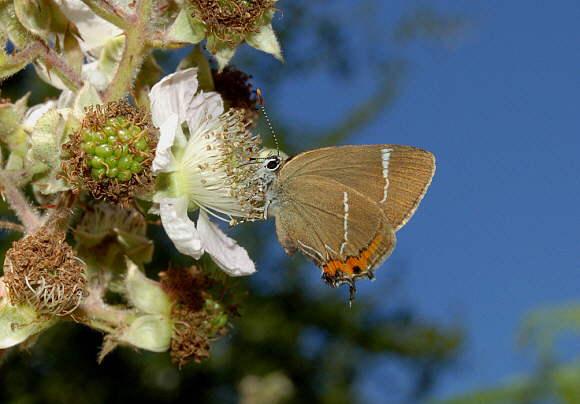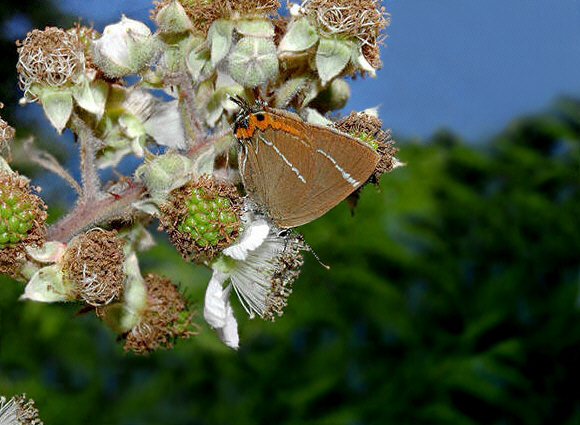 White-letter Hairstreak Satyrium w-album, male, Bentley Wood, Wiltshire – Adrian Hoskins
White-letter Hairstreak Satyrium w-album, male, Bentley Wood, Wiltshire – Adrian Hoskins
Introduction
The English and scientific names of this species both refer to the w-shaped white hair-line streak on the underside hindwings.
The butterfly is widely distributed in central and eastern Europe but is absent from Scotland, Ireland and northern Scandinavia. It’s range extends eastwards across temperate Asia to Japan.
Habitats
Prior to 1970 this was a common and widespread butterfly in southern Britain, though it has always been considered elusive, as it spends almost all of it’s life at the top of elm trees.
Tall elm trees dominated the British countryside for centuries, but almost entirely disappeared due to the arrival in Britain in 1976 of a virulent strain of Dutch elm disease, imported on elm logs from North America. The disease quickly spread, transported by elm bark beetles Scolytus multistriatus S.destructor and S.scolytus. The beetles live under the bark and propagate the ascomycete micro-fungus Ophiostoma novo-ulmi which is responsible for the disease. Within the space of 5 years the disease had ravaged Britain, destroying over 99% of the nation’s elms. White-letter Hairstreak caterpillars feed exclusively on the flowers and leaves of elms, so the loss of literally millions of trees spelt devastation for the butterfly.
In the case of English elms Ulmus procera, mature trees were killed, but the roots were unaffected, so sucker growth quickly returned. The tiny larvae of the butterfly hatch very early in the year, and need to feed at first on elm flowers, which appear about a month before the leaves. Unfortunately the age at which elms first flower coincides with the time they become attractive to the bark beetles and prone to further disease, so White-letter Hairstreak colonies are often short-lived.
The larvae also feed on wych elms Ulmus glabra, but these are now very rare. Most of the surviving trees are within fairly dense forest, where they have escaped the notice of the bark beetles.
Luckily the butterfly is a fairly mobile species, females in particular often being seen a considerable distance from their emergence sites wandering in search of healthy elms on which to lay their eggs. In exceptionally warm summers when butterfly dispersal is always highest they are sometimes able to establish new colonies to replace those that have been lost.
The trend however is one of continuing decline, and the species will remain very scarce until elms are able to develop a natural immunity to the fungal disease, or until very substantial numbers of disease-resistant strains of elm are established in Britain.
A program of research into disease-resistant elms has been under way for several years, and the best hope for the butterfly seems to centre around the planting and long term establishment of varieties including Lutece �, Vada �, and White Elm Ulmus laevis.
Lifecycle
The butterflies are single-brooded, emerging in late June and early July.
The dark brown eggs are shaped like an inverted saucer. They are laid singly in July on elm twigs, always at the point where the current year’s growth and the older growth meet. They are normally laid near the top of the tree, or on the sunlit southern side.
The larvae develop within the eggs in the autumn, but don’t hatch until late February or early March of the following year. In March 1980, a remarkably lucky bit of timing enabled me to watch a larva in the process of hatching. It nibbled its way out of the eggshell and then immediately sprinted along the twig until it found an elm flower, into which it bored and disappeared from view. The whole process from hatching to burial within the flower took no more than 15 seconds.
After feeding within the flowers for about 3 or 4 weeks, the larvae emerge and start to feed on the newly appearing leaves. When fully grown in early June, they can be found resting on the underside of the leaves.
I have found pupae, attached by a silk girdle to pads of silk spun on the undersurface of elm leaves, and have heard reports that they can also be found attached to small twigs.
Adult behaviour
The males emerge in late June or early July, and spend almost all of their lives sitting motionless on foliage at the top of wych elms or high on English elm sucker growth. They will sometimes fly up to chase and investigate other butterflies, and on such occasions up to 3 or 4 territorial w-album males can be seen spiralling rapidly around each other above the tree tops.
Females emerge about a week later than males. They probably mate at the emergence site and lay a high percentage of their eggs locally, but later disperse covering distances of at least 1km to lay the remainder of their eggs.
Both sexes are highly elusive, but occasionally descend from the trees to take nectar from bramble blossom, thistles or hemp agrimony. Sometimes it is possible to find up to half a dozen adults feeding together on flowers, usually within a few metres of the parent elm.

White-letter Hairstreak Satyrium w-album, male, nectaring at bramble – Adrian Hoskins
When nectaring, the butterflies walk about slowly over the flowers, repeatedly turning and changing position. The wing markings tend to direct the eye of human observers, and doubtless also of birds, away from the head ( which is usually half-buried within the flower ), and towards the tornus on the hindwings. These have short tails that probably function as “false antennae”, diverting bird attacks away from the vulnerable head.
